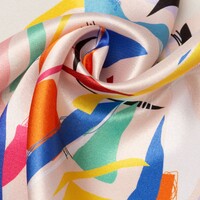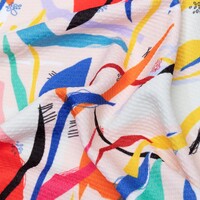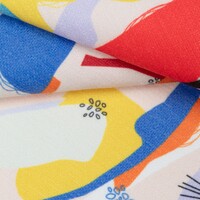Related:
Back to Site Stores ({{popupVm.storeTotalCount}})
Artists ({{popupVm.artistTotalCount}})
Create your own ottoman style fabrics using your photos, images and designs. Perfect for dresses, shirts a...
Read MoreShips in 1 - 2 days
US Shipping $9.95
Everything made to order
Ottoman fabrics have a variety of uses, and printing on them using your treasured memories is a great way to start a new project.
Browse our range of ottoman style fabrics
Faux suede fabric with a brushed/knapped face.
100% polyester
Poly fabric made of a satin weave.
100% polyester
Poly based jersey knit fabric.
96% polyester 4% elastane
Poly blend stretch jersey with pique knit.
97% polyester 3% elastane
Poly based cotton-twill look fabric.
100% polyester
2/2 twill poly blend weave.
100% polyester
Chenille yarn spun in traditional chenille weave.
100% polyester
Care instructions
86°F wash, low tumble dry heat or hang to dry, do not wring.






Ottoman is an ancient fabric that originates from Turkey, and can be dated back to the thirteenth century, and even potentially before that. It was originally woven with a silk warp and wool weft. In recent years, ottoman style fabrics are woven with any fibers but are characterized by the ribbing detailing. There are two types of ottoman; that which has a horizontal rib, which is known as an ottoman rib, it is made with highly sett warp yarns and a weft yarn which are slightly thicker, and ottoman cord, which has vertical ribs and is weft-faced.
The ottoman is a versatile piece of furniture that could serve as both a footrest and an additional seating option. The ottoman print fabric we make is carefully selected to complement the overall aesthetic of a room you are designing for. The printed fabric ottoman is designed with your pattern or photo that adds a touch of personality and character to your home. The custom fabric ottoman is made to order, allowing you to choose from a wide range materials and patterns to match their existing decor. The fabric for the ottoman was chosen for its durability and comfort, ensuring that it would withstand regular use while providing a comfortable place to rest your feet.
If you are looking for fabric to upholster an ottoman, why not take a look at our furnishing fabric ?
We print your ottoman fabrics designs directly onto the material itself, using
Once your fabric is printed, you can choose how you want it to be finished. Our craftsmen can send it 'as is'. This means that they will cut it down to an approximate size, roughly around the edges, but will leave a border of unprinted fabric around the edges for you. They can also 'cut on the line' where they will follow the edge of your design, and remove all the white edges. Either way, the ottoman fabrics you receive will b to the bespoke dimensions you provided us.
If you'd rather, the craftsmen can pass your fabric onto our expert seamstresses, who can hem your ottoman style fabrics with either a folded hem using a straight stitch or with an overlocked hem. Bear in mind that if you choose this option you may need to add a little onto your custom sizes to ensure that your personalized ottoman fabrics are the right size for your project after hemming.
We print at 200dpi, which is a good combination of quality and file weight. Ideally, your image should be scaled to 100% at 200dpi; this means that no resizing of your file occurs, preventing any interpolation. Our design interface will have a quality marker next to the design that you have uploaded, this will change color using a traffic light system and display a message. The message will let you know if the resolution is too low or if you have a good quality image.
When you upload your design our system will automatically scale it to fit your chosen fabric dimensions. In the ‘Product Image’ tab, the displayed dimensions under ‘Print Size’ will show the dimensions of the piece of fabric that you are ordering. For image/design dimensions you need to see the ‘Images & Text Tools’ tab. You can see and edit the dimensions of the image under the quality information next to the thumbnail.
We advise providing images in the RGB color space. Specifically using the sRGB image profile, to achieve best color results. What does this mean? In your editing software, choose RGB as the working space and assign the image profile as sRGB (full name sRGB IEC61966-2.1)
For most of our fabrics, there is no limit on the length of the fabric that you can order. We have a preview design window set up to 10 yds max to visualize the print, but that's not a print limit. If you'd like to order more, increase the quantity (x2 for 20 yds or x4 for 40 yds for e.g.) and then you can order as much as you'd like, with a built in automatic volume discount too. The maximum print width of each fabric can be found on the individual fabric pages or in our design interface.
Yes, that might help you! Always incorporate any extra space or borders into your purchased fabric size. We trim squarely around fabric samples and fabric prints, leaving approximately 0.2" white space. Cutting neatly on the line has an additional fee.
Crocking, which is fading along the creases, often after washing or heavy use, occurs when you digitally print on natural fabrics - more so when dark or dense colors are used. It can be minimized by using a cool hand wash instead of machine washing as the tumbling of the machine is the main cause of this. To avoid entirely, we would advise using a poly fabric.
Our organic fabrics do not have any coatings that the non-organic fabrics have. This means the ink absorbs into the fibers, reducing the color strength slightly (by approx. -40%). For super-strong colors, we recommend a non-organic natural fabric.
Unfortunately not; we like to test meticulously so that we know what gets the best results on our fabrics, and our facilities cater perfectly to them. We do however print sublimation transfer paper to order, and if you have access to a heat press you can press your own fabrics easily.
For multi-colored or very detailed files we recommend using a tiff format, but they must be flattened. For simple colors and low detail files, a jpeg is fine.
Just like many fabric printing processes, there is the potential for shrinkage. Depending on the fabric, please expect and allow between 2-8% shrinkage which you need to plan for in your dimensions. This percentage can vary from print run to print run and between fabrics, so we would advise to order a little more material than you require for your project.
We do not offer to print on both sides of the fabric, as a lot of our fabrics are semi-transparent or have some show through. This wouldn't work with double-sided printing. This is not a service that we offer on any of our fabrics.
At the moment no, our labels are all printed on the same satin fabric. We may introduce more in the future, but for now, this is the best choice. The labels are all cut the same way. You can order the fabric of your choice and make the labels yourself, but we do not cut different fabrics into label format.
With environmental consciousness in mind, our fabrics are all printed using completely water-based inks. This means no chemicals or solvents are used. Our heat fixing procedure fixes the colors and prints, avoiding the downsides of steaming, such as excess or contaminated water returning into the waste system. We have one facility where we conduct all the printing, production and fulfillment. Rather than roll the fabrics, or send them in a tube, we fold them before they are sent out to you. This saves over 150 tubes a week, as well as a lot of space on the delivery van. (For delicate fabrics we ensure to package appropriately).
We work at improving our color profiles all the time. Though rare, it may happen that from one print run to another, and there could be slight color differences, this is normal and part of the process when we are constantly improving. It is extremely unlikely that there will be a huge difference (like orange instead of red for example). Please bear in mind such color variations can be intensified from fabric to fabric due to the varying grains and textures of the fabric. This is due to the construction of the materials as well as the print methods that have to be altered slightly for more delicate, natural textiles.
We have a full Cut & Sew service here at Bags of Love, and are able to hem your fabric prints for a small additional charge. We create a small one- or two-fold hem that typically uses 0.2" to 0.75" (5-20mm) of material, depending on the thickness of the fabric. So, for example, if you want a finished piece of fabric that measures 39.37" x 39.37", you will need to order a size of 39.96" x 39.96" to allow for the hem (on top of that please also allow for shrinkage of min 2%). The thicker the fabric, the bigger the hem will be. You can choose to have your prints hemmed with either Black or White thread. On our silk and other light woven fabrics, one hemmed edge will be straight (vertically down the roll) and the other will be slightly rippled. The hemming material allowances are as follows and you need to make your print bigger to accommodate the hem:
All of our fabrics are cut manually by hand, with the utmost care and attention. If your fabric has a slightly uneven look on the edges or a touch of fraying, this does not indicate a flaw in the textile. It is not always possible to achieve a perfectly straight cut with certain fabrics, so please do bear this in mind when it comes to your design. If you have any queries or would like to know about our cutting methods in more detail, please get in touch and we will be more than happy to discuss them with you.
For further information about our fabrics see our FAQs.
Please note: As everything we provide is handmade to order, you may find a slight variance in the sizes.











